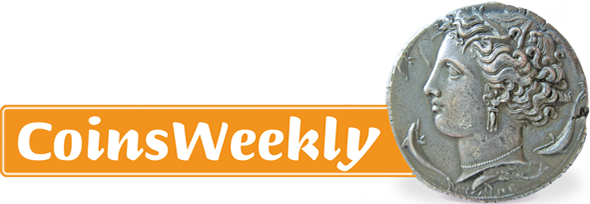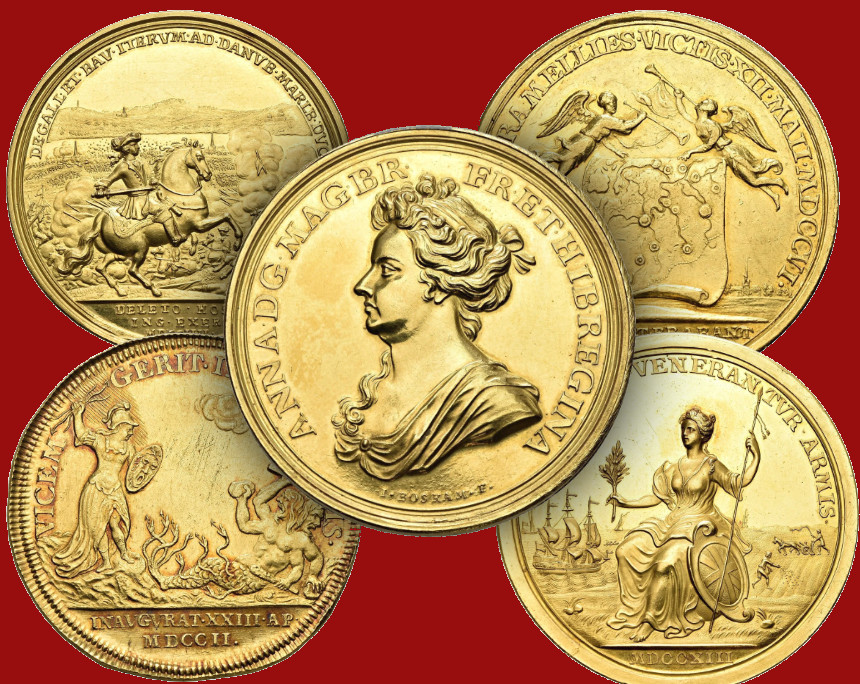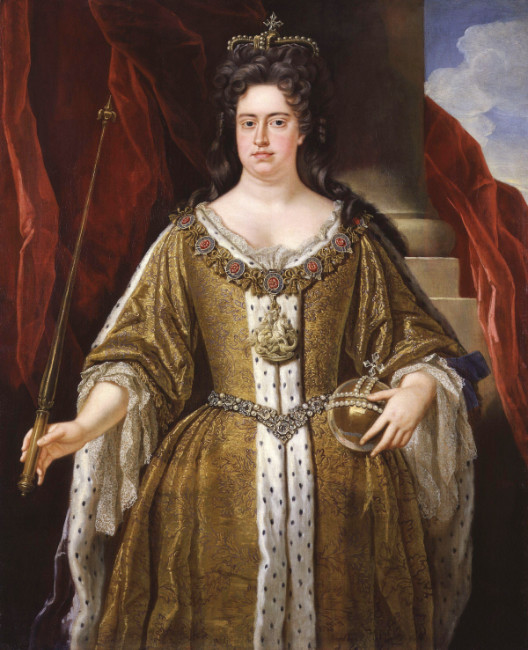Queen Anne: Great Britain on Its Way to Becoming a Global Power
by Ursula Kampmann
On 26 May 2025, SINCONA will auction off part 6 of the British Collection presenting the medals of this ensemble. In this article, we will show you some of the treasures among the lots and explore the story of Queen Anne. Under her rule, Great Britain became the most important trading power in Europe.
Inhalt
What do you know about Queen Anne? Numismatists will immediately think of the Vigo raid and the English coins struck from Spanish silver. Art connoisseurs will picture an architectural style, antiques dealers a particular type of furniture, cineastes Olivia Colman – and that’s about it.
But none of this does justice to Queen Anne. She did not have an easy life. And yet she had a profound impact on setting Britain’s course for the future. In this article, we will tell you all about it through her medals.
The Background
Let us first examine why Queen Anne came to power in the first place. This requires a look at her lineage. Anne’s father was James II, the younger brother of Charles II, who had regained his father’s throne after Cromwell’s death. As Charles II had no children, James inherited the throne. However, he was very unpopular with the upper classes. This was mainly due to a conflict of interest: James wanted to rule – and so did the upper classes. Religion was nothing but a wonderful excuse to cover up their own lust for power. That is why the upper classes condemned James’ conversion to Catholicism and his second marriage to a Catholic woman. This had few consequences as long as the children from this marriage kept dying. But then the queen gave birth to a son who survived and became the legal heir to the throne.
An heir with undoubted dynastic legitimacy would have drastically reduced the influence of the upper classes on the royal office. And he was a Catholic! You can decide for yourself which of these two arguments motivated the seven British nobles to offer William of Orange the kingship just twenty days after his birth. William was not only a Calvinist, but also the husband of Mary, James’ eldest daughter from his first marriage. It was therefore possible to construct a claim to the throne. William and Mary brought in the Dutch army, James fled with his wife and the pretender to the throne; on 11 April 1689, England had a new king and queen. Propaganda would later hail the events as the Glorious Revolution, but it is probably more correct to talk of a coup d’état.
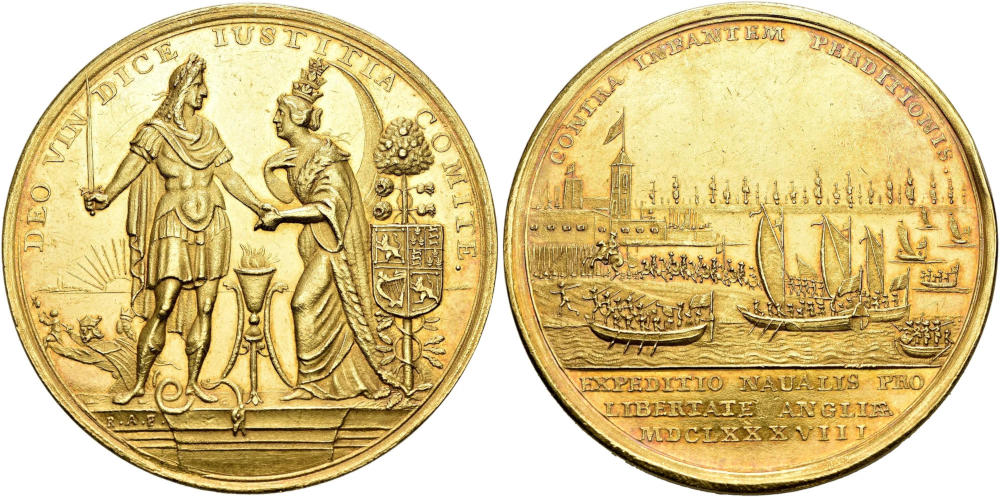
Gold medal commemorating the landing of William of Orange at Torbay in 1688, created by R. Arondeaux. 49.3 mm. 58.41 g. Extremely Fine. Estimate: CHF 15,000. From SINCONA Auction 96 (26 May 2025), No. 134.
Medals like these contributed to the myth of the Glorious Revolution. The reverse shows a female personification, with the three crowns of England, Scotland and Ireland on her head. She bows to William, dressed as a Roman emperor, and greets him with a handshake. The orange tree, entwined with English roses and Scottish thistles, also represents the alliance. The sun rises in the background, heralding the country’s new and glorious future, while the old king flees below.
The inscription tells us how to interpret the scene: With God as protector and justice as companion. The reverse depicts Dutch invasion troops fighting, as the inscription claims, against the child of destruction and for English freedom. Of course, this propaganda has nothing to do with historical truths.
Why Did Queen Anne Ascend the Throne?
Mary died childless of smallpox in 1694, aged just 32. This was not a problem until 29 June 1700. For she had her younger sister Anne, who could inherit the throne after William’s death. And Anne, despite twelve miscarriages and the loss of four children, still had a son, now a proud 11-year-old, who would inherit the throne after her. But on 29 June, the boy died of smallpox. It was a tragedy not only for the mother, but also for the English nobility as the new line of rulers, which had been so carefully established, had undoubtedly come to an end. There was a very real risk for power to return to James II. That would have been a catastrophe! Not because he was Catholic, but because he would have disempowered all those involved in his expulsion.
What followed was the Act of Settlement – another euphemism. For it was not a settlement, but another breach of law. On 24 June 1701, Parliament voted to strip James II and his descendants of all rights to the throne and to transfer the claim to Sophie of the Palatinate, a granddaughter of James I through her mother.
The decision was made just in time because William died on 19 March 1702 as the result of a riding accident and Anne (but not her husband George!) was crowned.
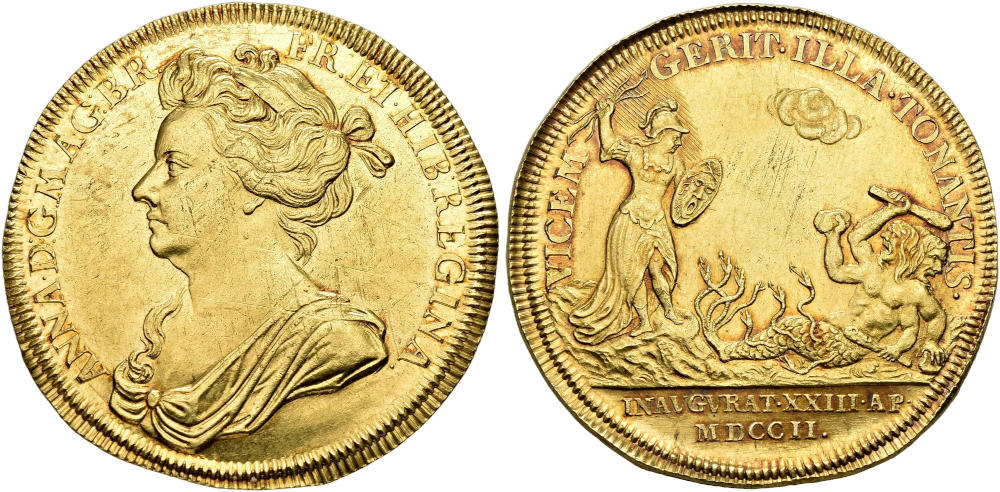
Gold medal commemorating the coronation of Queen Anne in 1702. 35.4 mm. 18.57 g. Extremely Fine. Estimate: CHF 10,000. From SINCONA Auction 96 (26 May 2025), No. 197.
The Coronation of Queen Anne
This is remarkable. Was Parliament afraid of having to deal with another king as decisive as William? Indeed, parliamentarians tried to curb the Queen’s power in other ways. They passed a plethora of laws that almost anticipated the modern separation of powers.
This makes the depiction Queen Anne chose for her coronation medal all the more interesting. It shows her as Pallas Athena, killing a giant with lightning. The inscription reads: She is the Vice-Regent of the Thunderer. At first sight, this appears to be a strange motif and an unusual inscription. But the English upper classes remembered all too well another medal designed on behalf of Anne’s grandfather, Charles II, to mark his return to the throne in 1660: Zeus, representing Charles II, hurls his thunderbolts at the earthlings, symbolising the men who had robbed his father of his office and his life.
With this motif, Anne sent a clear warning to her political opponents to take her and her reign seriously. Indeed, over the next few months, she managed to significantly strengthen her position vis-à-vis Parliament.
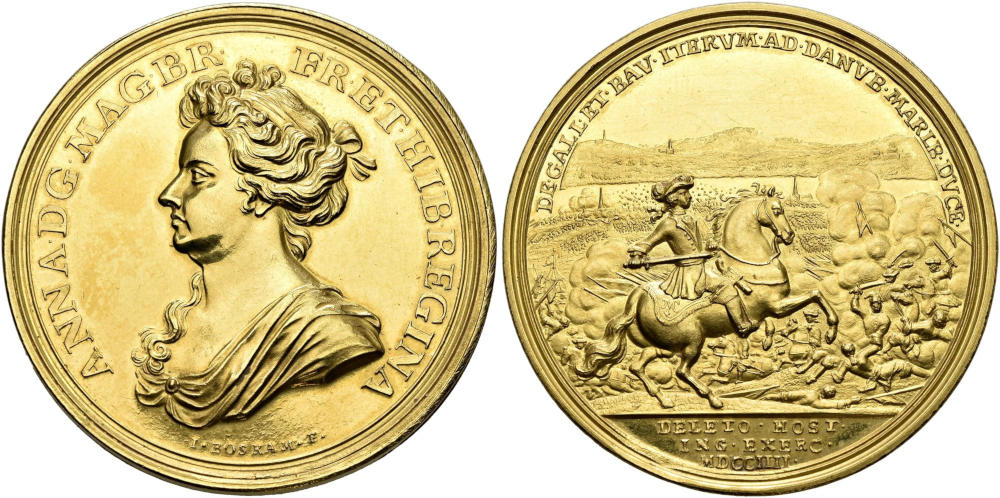
Gold medal commemorating the victory of Blenheim in 1704 by J. Boskam. 44 mm. 49.91 g. Estimate: CHF 15,000. From SINCONA Auction 96 (26 May 2025), No. 205.
The Duke of Marlborough
The people she surrounded herself with also helped in this regard. She had to thank her predecessor for her most important supporter. William had appointed John Churchill, Earl of Marlborough, as commander-in-chief of his forces.
This was in response to the death of the Spanish King Charles II, who had died childless on 1 November 1700. With his death, the Spanish Empire was up for grabs. Of course, the Austrian Habsburgs laid claim to it. But the rising power of France under Louis XIV would have loved to take it over, too. This would have had unforeseeable consequences for world trade, a risk that England and the Netherlands were not willing to take. Nevertheless, it was a stroke of genius on Churchill’s part to persuade both the Habsburg Emperor Leopold I and the Dutch States-General to take joint action against France – both diplomatic and, above all, military.
The Battle of Blenheim, won by the allies on 13 August 1704, was the fruit of Churchill’s talent, as this medal shows. Churchill dominates the scene on horseback. The circumscription also focuses on him: Under Marlborough’s command, the French and Bavarians were once again defeated on the Danube, crushing the immense army of the enemy.
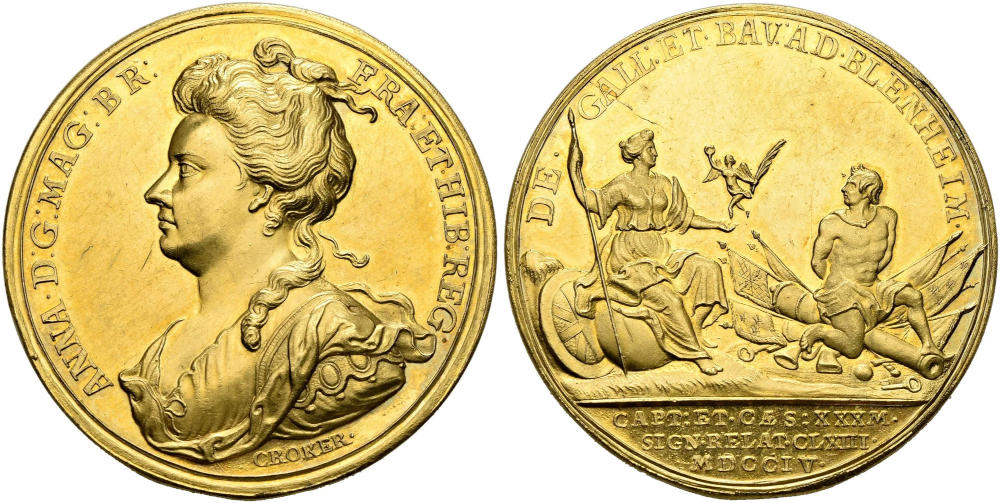
Gold medal commemorating the victory of Blenheim in 1704 by J. Crocker. 34.4 mm. 25.13 g. About Uncirculated. Estimate: CHF 10,000. From SINCONA Auction 96 (26 May 2025), No. 206.
The Victory of Blenheim
The enemy army was crushed. That is correct. Because two military geniuses had worked together: Churchill and Prince Eugene of Savoy. With the Battle of Blenheim – or the Battle of Höchstädt, as the German and French call it – they did lasting damage to the French aura of invincibility. This gold medal proclaims in its circumscription: 36,000 French and Bavarians captured and killed in Blenheim; 163 field insignia captured.
It shows Britannia enthroned on a globe with a spear and Victoria. At her feet a naked warrior, kneeling on the captured weapons and some keys. The keys represent the many cities that came under imperial rule as a result of the victory. Max Emanuel had to go into exile; his Bavaria was occupied; France lost all influence in southern Germany.
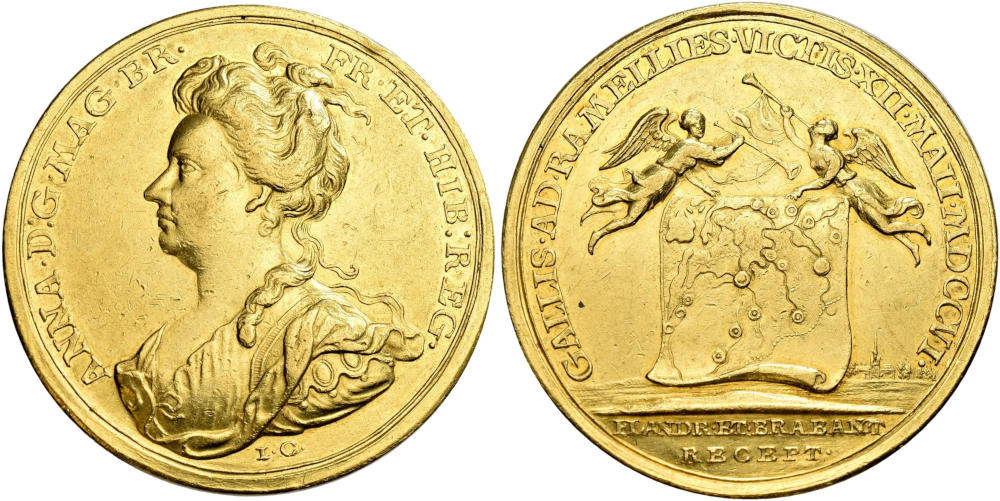
Gold medal commemorating the Battle of Ramillies in 1706 by J. Crocker. 34.9 mm. 24.28 g. Very Fine to Extremely Fine. Estimate: CHF 5,000. From SINCONA Auction 96 (26 May 2025), No. 214.
The Victory of Ramillies
Two years later, Churchill won another major victory near the Belgian town of Ramillies. Again, his opponents lamented not only heavy losses – 13,000 men died and 6,000 were captured – but also the enemy’s reconquest of the Spanish Netherlands, with the rich trading cities of Bruges, Antwerp and Ghent.
The way in which Crocker depicted the event on this medal was rather innovative: we see the involved provinces on a map, the two Famae, messengers of the gods with long trumpets, between them.
The Act of Union 1707
And yet it was not these great victories that paved the way for the Act of Union 1707 – the unification of England and Scotland into Great Britain – but a mixture of chance, economic mismanagement and political interests.
After all, the Scottish Parliament had repeatedly toyed with an alternative succession arrangement in favour of James II, much to the displeasure of English politicians. As an independent kingdom with its own parliament, Scotland could – in a worst-case scenario – have seceded under its own ruler, especially because England’s forces were tied up abroad.
But then the Scottish economy went into a tailspin. First came the Seven Lean Years, during which the common people suffered terribly. Poor harvests led to famine, which killed between 5% and 15% of all Scots.
The upper classes were hardly affected, but they too had economic worries. They had backed the wrong horse. Scottish investors had wanted to participate in world trade and had set up a trading company for this purpose that was supposed to operate a trading colony in the Darién Gap, of all places. The problem was the scale of the investment. Around 20% of Scotland’s total financial resources had been invested in the project. When the trading company collapsed and all investors lost their money, Scotland ran the risk of suffering from an uncontrollable economic crisis. It was in this moment that the English parliament tempted Scotland with the prospect of a union and the vast sums of money that would flow to Scotland. The deal was struck. And to this day, Scottish folk singers castigate the rogues who sold Scottish freedom for English gold.

Silver medal commemorating the union of England and Scotland in 1707 by J. Croker. 47.2 mm, 42.11 g. Extremely Fine. Estimate: CHF 300. From SINCONA Auction 96 (26 May 2025), No. 218.
A silver medal commemorates the event. Its reverse shows the English lion (with crown!) with a shield depicting the Scottish thistle. To its left is the Scottish unicorn. It wears a crown around its neck, with the usual chain, and presents an early form of the Union Jack: the English Saint George’s Cross superimposed on the Scottish Saint Andrew’s Cross.
Look carefully at the bust of the Queen, as you will see this depiction of gown and crown again on an undated gold medal, which must therefore have been made at about the same time.
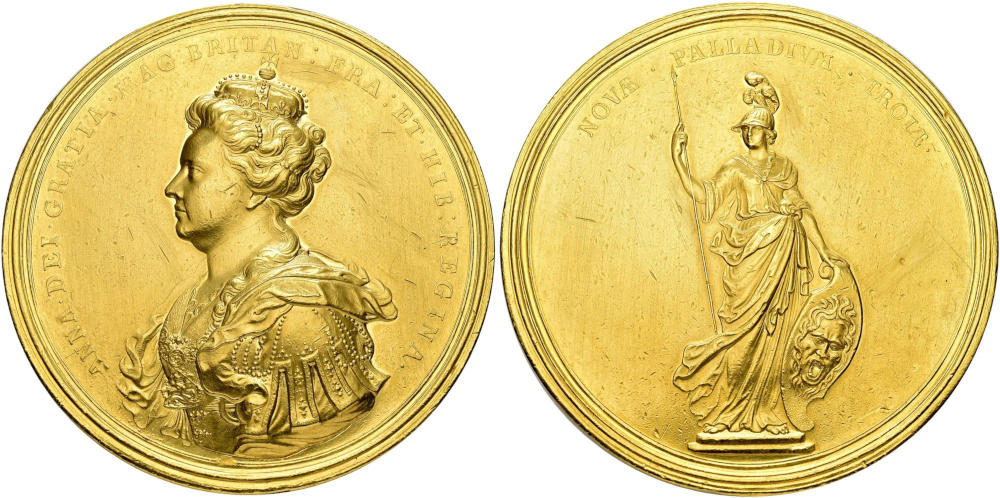
Gold medal commemorating the union of England and Scotland in 1707, unsigned by J. Croker. 70.5 mm diameter. 272.08 g. Attractive Very Fine. Estimate: CHF 25,000. From SINCONA Auction 96 (26 May 2025), No. 219.
We are talking about a heavy gold medal that does not seem to refer to a particular historical event. It rather describes Anne’s role in the new United Kingdom. It echoes the theme of the coronation medal. We see a defending Anne with spear and Medusa’s shield. The inscription reads: The Palladium of New Troy.
The palladium was the most sacred object of worship in ancient Rome. As we know from Vigil’s Aeneid, the Roman believed that their forefather Aeneas had rescued it from the burning city of Troy, because no city could perish as long as it fought just wars and kept the palladium within its walls. He took the palladium to Rome, where the Vestal Virgins kept it.
By linking herself to this myth, Anne presented herself as a guarantor of security in the new Great Britain created by the union of England and Scotland.
We should also remember that, in the early 18th century, gold and silver medals were not intended as collectors’ items but mainly used as gifts of great monetary value in diplomatic circles. We can well imagine that Queen Anne wanted to use these noble gifts to win supporters for her policies as the united parliament reorganised itself.
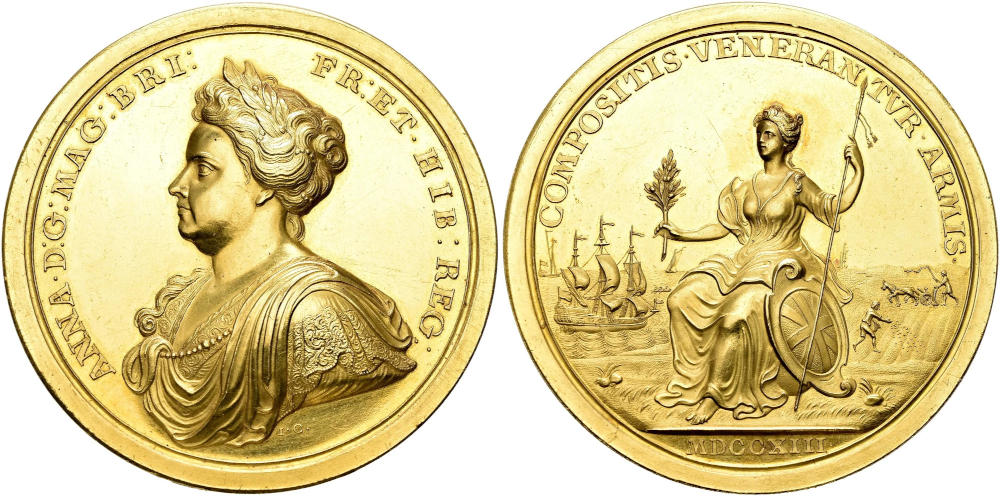
Gold medal commemorating the Peace of Utrecht in 1713, by J. Crocker. 59.3 mm. 122 g. Extremely Fine to Uncirculated. Estimate: CHF 15,000. From SINCONA Auction 96 (26 May 2025), No. 245.
The Treaty of Utrecht
Although Anne was the de facto Queen, Parliament drastically limited her powers. And, just like today, Parliament was dominated by parties that not only had their own worldviews but also put the interest of their clientele first. The Whigs, led by John Churchill, fought the Tories, who wanted to end the costly war over the Spanish succession and reduce the tax burden. The Tories won the election in 1710 and immediately began to negotiate a seperare peace agreement with France. They succeeded in getting the Congress for Peace to begin in Utrecht on 29 January 1712. As early as on 11 April 1713, the congress achieved important agreements between the British and the French. The British had been very accommodating to Louis XIV! The terms of the treaty did not reflect the military reality in any way.
Britain recognised Louis XIV’s grandson as the new ruler of Spain, as long as he promised that France and Spain would never be united in a personal union under a member of the House of Bourbon. (It is interesting to know that he was in no place to make such a promise because of the Salic Law of Succession.) In return, Louis XIV renounced any further support for the descendants of James II.
Britain secured a number of important pieces from Spain’s possessions – including Gibraltar, Menorca and the monopoly on the lucrative slave trade with the Spanish colonies in America. In addition, there were large territories in North America that were to become the profitable heart of the British colonies. Great Britain left the negotiating table as the most important trading power in Europe, as this medal shows: in addition to Britannia, we see a plethora of different types of ships, all used in trade.
Anne’s Death
While the diplomats in Utrecht worked out the final details of the peace agreement, Anne faced a serious crisis in government. Lord Treasurer Robert Harley was losing the support of even his closest friends. Anne herself was also extremely upset by his behaviour. She was seriously ill herself, often bedridden, in failing health, and had to deal with a Lord Treasurer who neglected his office, often arrived late, even drunk at official meetings, was disrespectful of her, and seemed to have lost control of the situation. 27 July 1714 Anne publicly announced that she had lost confidence in Robert Harley, and he was forced to resign. But even after two crisis meetings, the Queen was unable to form a new government. It was a situation that weighed heavily on her mind.
On 30 July 1714 – just before the third emergency meeting – she suffered a stroke which left her unable to speak. She died on 1 August 1714 at 7.30 am. We know what her personal physician wrote to a friend: “I believe sleep was never more welcome to a weary traveller than death was to her.” Anne was not even 50 years old!
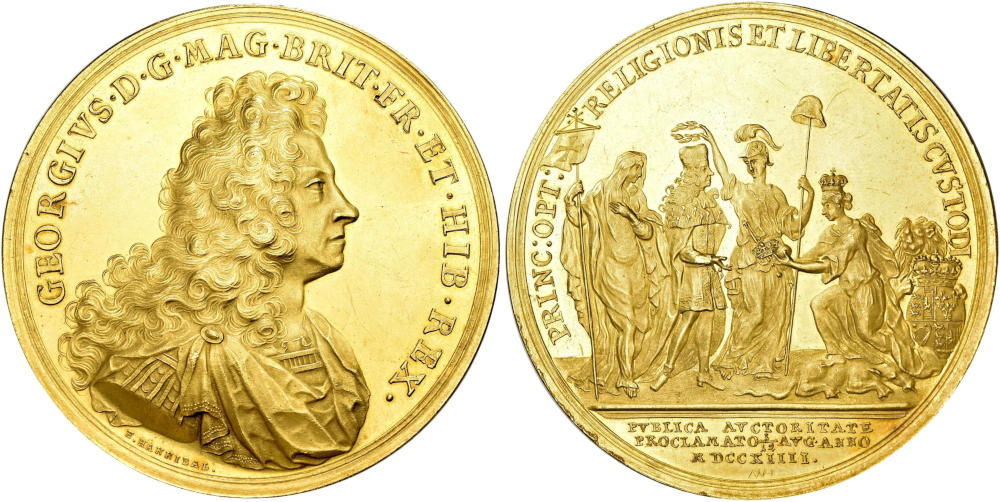
Gold medal commemorating the proclamation of George I on 12 August 1714 by E. Hannibal. 66.8 mm. 172.97 g. Extremely Fine to Uncirculated. Estimate: CHF 30,000. From SINCONA Auction 96 (26 May 2025), No. 255.
A German Ruler on the English Throne
It was time for the question of succession. The whole of England was wondering who would take over: a Stuart or this German Elector from Hanover who could not even speak proper English. We know what happened. The House of Hanover would rule England until 1901, when it was replaced by the House of Saxe-Coburg and Gotha, which was renamed the House of Windsor in the middle of the First World War.
And the Jacobites? They tried several times to take the British throne. They did not succeed.






